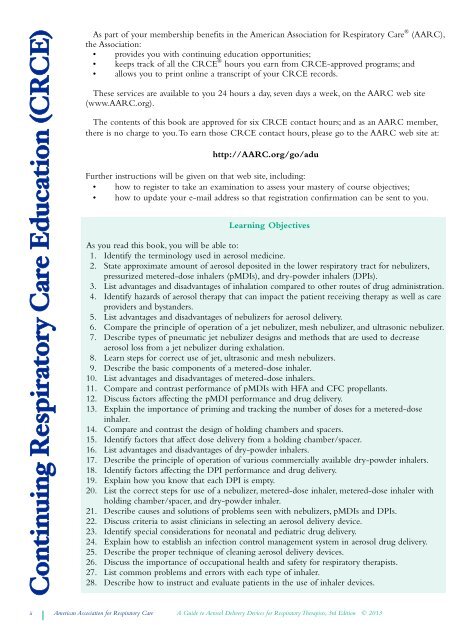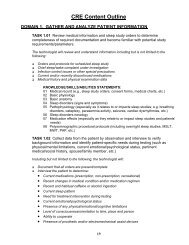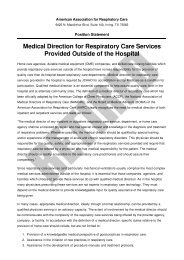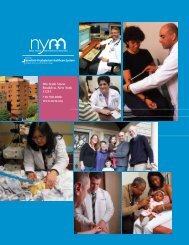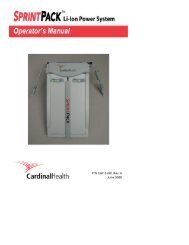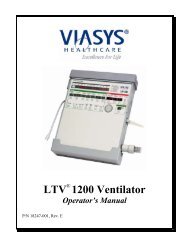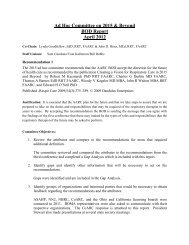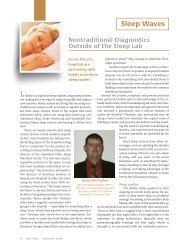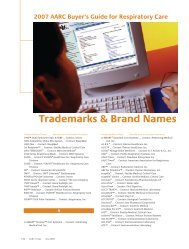Aerosol Guide - AARC.org
Aerosol Guide - AARC.org
Aerosol Guide - AARC.org
Create successful ePaper yourself
Turn your PDF publications into a flip-book with our unique Google optimized e-Paper software.
Continuing Respiratory Care Education (CRCE)<br />
As part of your membership benefits in the American Association for Respiratory Care ® (<strong>AARC</strong>),<br />
the Association:<br />
• provides you with continuing education opportunities;<br />
• keeps track of all the CRCE ® hours you earn from CRCE-approved programs; and<br />
• allows you to print online a transcript of your CRCE records.<br />
These services are available to you 24 hours a day, seven days a week, on the <strong>AARC</strong> web site<br />
(www.<strong>AARC</strong>.<strong>org</strong>).<br />
The contents of this book are approved for six CRCE contact hours; and as an <strong>AARC</strong> member,<br />
there is no charge to you. To earn those CRCE contact hours, please go to the <strong>AARC</strong> web site at:<br />
http://<strong>AARC</strong>.<strong>org</strong>/go/adu<br />
Further instructions will be given on that web site, including:<br />
• how to register to take an examination to assess your mastery of course objectives;<br />
• how to update your e-mail address so that registration confirmation can be sent to you.<br />
Learning Objectives<br />
As you read this book, you will be able to:<br />
1. Identify the terminology used in aerosol medicine.<br />
2. State approximate amount of aerosol deposited in the lower respiratory tract for nebulizers,<br />
pressurized metered-dose inhalers (pMDIs), and dry-powder inhalers (DPIs).<br />
3. List advantages and disadvantages of inhalation compared to other routes of drug administration.<br />
4. Identify hazards of aerosol therapy that can impact the patient receiving therapy as well as care<br />
providers and bystanders.<br />
5. List advantages and disadvantages of nebulizers for aerosol delivery.<br />
6. Compare the principle of operation of a jet nebulizer, mesh nebulizer, and ultrasonic nebulizer.<br />
7. Describe types of pneumatic jet nebulizer designs and methods that are used to decrease<br />
aerosol loss from a jet nebulizer during exhalation.<br />
8. Learn steps for correct use of jet, ultrasonic and mesh nebulizers.<br />
9. Describe the basic components of a metered-dose inhaler.<br />
10. List advantages and disadvantages of metered-dose inhalers.<br />
11. Compare and contrast performance of pMDIs with HFA and CFC propellants.<br />
12. Discuss factors affecting the pMDI performance and drug delivery.<br />
13. Explain the importance of priming and tracking the number of doses for a metered-dose<br />
inhaler.<br />
14. Compare and contrast the design of holding chambers and spacers.<br />
15. Identify factors that affect dose delivery from a holding chamber/spacer.<br />
16. List advantages and disadvantages of dry-powder inhalers.<br />
17. Describe the principle of operation of various commercially available dry-powder inhalers.<br />
18. Identify factors affecting the DPI performance and drug delivery.<br />
19. Explain how you know that each DPI is empty.<br />
20. List the correct steps for use of a nebulizer, metered-dose inhaler, metered-dose inhaler with<br />
holding chamber/spacer, and dry-powder inhaler.<br />
21. Describe causes and solutions of problems seen with nebulizers, pMDIs and DPIs.<br />
22. Discuss criteria to assist clinicians in selecting an aerosol delivery device.<br />
23. Identify special considerations for neonatal and pediatric drug delivery.<br />
24. Explain how to establish an infection control management system in aerosol drug delivery.<br />
25. Describe the proper technique of cleaning aerosol delivery devices.<br />
26. Discuss the importance of occupational health and safety for respiratory therapists.<br />
27. List common problems and errors with each type of inhaler.<br />
28. Describe how to instruct and evaluate patients in the use of inhaler devices.<br />
ii American Association for Respiratory Care A <strong>Guide</strong> to <strong>Aerosol</strong> Delivery Devices for Respiratory Therapists, 3rd Edition © 2013


